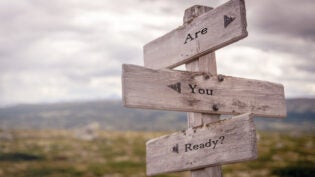
“People can’t inspire others unless they are inspired themselves.”
—Carmine Gallo, Talk Like TED
My buddy Rand Stagen runs a leadership academy in Dallas. He’ll tell you he helps entrepreneurial leaders of companies with hundreds of millions in revenue scale to billions in sales. While this may be the outcome, I believe his most valuable skill is helping leaders see that their teams are simply reflections of themselves.
If that’s true—and I sincerely believe it is—then sometimes it is important to get out of your own way.
That just makes sense. When the leader is focused, the team is focused. When the leader is oozing with mojo, so too is his team. And when the leader is out of gas…well, you see where this is going.
Leadership guru Marshall Goldsmith wrote a great book in 2010 titled MOJO. The year before the book was published, I shared a quiet moment with him at an entrepreneurial gathering that I was chairing.
I had asked Goldsmith to come speak to the group about leadership. During our conversation, I admitted that I was feeling run down and feared that “I had lost my mojo.” Marshall responded by saying something like, “Well then, your team has probably lost its mojo too.”
He was spot on. Every team becomes a reflection of their leader, good and bad, and it is absolutely natural for leaders to run out of gas occasionally. The crown is heavy.
After speaking to Marshall and some other trusted advisors, I knew I had to do some work on myself first, company second. I took an intentional, lengthy break, during which I left my phone and computer on one continent and spent four weeks with my family, wine, cheese and lavender on another one. Our executive team could have reached me if Rome was burning, but it would have involved a carrier pigeon or a Frenchman on a Vespa.
It worked. The following two years were the best our company had ever had. I am convinced that it was directly related to some major decisions that were made obvious by the perspective that comes with a clear head.
So if your mojo-meter is running on fumes, here are a few simple ways to refuel:
Take a Break
Sometimes the most obvious ideas are the best ideas. When was the last time you really got away from your business? The axiom that you can’t work on your business when you are working in your business is true. One of the best ways to get new perspective and the energy to act upon it is to leave your business behind—for a while.
Verne Harnish, founder of the Entrepreneurs’ Organization (now EO) and Gazelles, recommends you step away from your business and take a sabbatical every seven years.
For this strategy to work, you really have to be committed to leaving your business behind. Take at least three weeks and commit to not checking email or calling in to see how things are going without you. If possible, go to a completely foreign location—the more off the grid the better. Your goal is to be completely distracted by things other than business.
I have done this twice now in my 25 years of business. Upon returning from each trip, I was able to see things more clearly, and the results were extraordinary. I learned that necessary changes that I was putting off because they required too much emotional capital were much easier to make upon return. I also noticed that it was easier to make subtle connections that lead to disproportionate returns. For example, returning from one trip, I repositioned our company and started a new one. These shifts would have required “juice” that I didn’t have when I left the country.
Take a Nap
Naps aren’t just for grandparents and babies; leaders everywhere have learned about the value of 30 minutes of downtime. A NASA study on pilots found that a 40-minute nap improved performance by 34 percent. The National Sleep Foundation even describes napping as a minivacation.
It’s up to you as a leader to make taking quick breaks OK. We have a room in our office that is used for napping. I am delighted when I see someone emerging from a mid-afternoon break because it means that they feel comfortable taking care of themselves and they will be performing at a higher level for the rest of the day.
Switch Jobs
I’ve joked for years with my entrepreneurial friends that we ought to do a “boss swap,” during which we’d run each other’s companies for a period of time. While running the friend’s firm, we’d have carte blanche to make any decisions we thought necessary for the good of the company and its shareholders. After all, it’s always easier to solve other people’s problems than it is your own.
Thankfully, there are simpler and perhaps less dramatic ways to switch jobs. They are called special projects. Just pick a really big challenge that is new to you. This could be in your department, another department or within a client’s company. Commit to working on this singular challenge. Establish a time limit to get the challenge solved. Since this is essentially a working sabbatical, a good rule of thumb is four to six weeks, but even dedicating a week to something completely different will work wonders. Choose the biggest, most important challenge you believe you can solve within that time so you are completely distracted and engaged.
Switching jobs will give you a fresh, meaningful problem to solve. It will allow your brain to stop grinding on your old challenges, and it will remind you that you are a great problem solver. As long as you pick the right challenge, you will find that this practice is invigorating. It’s important. It’s worthy of your time.
Focus on Future Outcomes
I’ve noticed that for leaders, the past sucks energy, but the road ahead fuels mojo. The solution to this is simple on paper but hard for many to implement: We must always be focused on the future we want.
The easiest way to do that is to simply ask this question constantly: “What is the outcome I want?” Great leaders have the ability to focus and refocus themselves and their teams on this powerful question. And in doing so, they are constantly writing a story about a better future instead of reflecting on a past that they cannot change.
One last bit of experience to share. Social media can be insidious. It is impossible to check out if you are always checking in. So when you take a break, leave your smartphone in a drawer. The world will be fine without you for a while.











